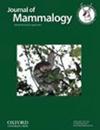Assessing responses to heat in a range-shifting, nocturnal, flying squirrel
IF 1.6
3区 生物学
Q2 ZOOLOGY
引用次数: 0
Abstract
Over the last few decades North American flying squirrels (Glaucomys spp.) have experienced dramatic northward range shifts. Previous studies have focused on the potential effects of warming winter temperatures, yet the hypothesis that rising summer temperature had a role in these range shifts remained unexplored. We therefore sought to determine the effect of high environmental temperatures on the thermoregulation and energetics of flying squirrels in an area of the Northeast of North America with a recent species turnover. Unable to find a logistically feasible population of the northern species (Glaucomys sabrinus), we focused on Southern Flying Squirrels (G. volans). Using flow-through respirometry, we measured the relationship between metabolic rate, evaporative water loss, and body temperature at high ambient temperatures. We also measured core body temperature in free-ranging flying squirrels using temperature-sensitive data loggers. We detected no significant increase in metabolic rate up to ambient temperatures as high as 40 °C. However, evaporative water loss increased at temperatures above 36.2 °C. Free-ranging body temperature of flying squirrels followed a circadian pattern with a ~2 °C difference between active and resting phase modal body temperatures. Rest-phase body temperatures were influenced by environmental temperatures with higher resting temperatures observed on days with higher daily maximum ambient temperatures but not to an extent that energy or water costs were significantly increased during rest. We found that, due to a relatively high level of thermal tolerance, high ambient temperatures are unlikely to cause an energetic strain on Southern Flying Squirrels. However, these findings do not preclude negative impacts of high ambient temperatures on the northern species, and these may still play a role in the changing distributions of Glaucomys in North America.评估鼯鼠对热的反应
在过去的几十年里,北美鼯鼠(Glaucomys spp.)的分布范围发生了急剧的北移。以前的研究主要集中在冬季气温升高的潜在影响上,但关于夏季气温升高在这些范围转移中的作用的假设仍未得到探讨。因此,我们试图在北美东北部最近发生物种更替的地区确定高环境温度对鼯鼠体温调节和能量学的影响。由于无法找到在逻辑上可行的北方物种(Glaucomys sabrinus)种群,我们将重点放在南方鼯鼠(G. volans)上。我们使用流过式呼吸测定法测量了高环境温度下新陈代谢率、蒸发性失水和体温之间的关系。我们还使用温度敏感数据记录器测量了自由活动鼯鼠的核心体温。在高达40 °C的环境温度下,我们检测到新陈代谢率没有明显增加。然而,当温度超过 36.2 °C时,鼯鼠的蒸发失水增加。鼯鼠的自由活动体温遵循昼夜节律,活动期和静止期的模态体温相差约 2 °C。静止期体温受环境温度的影响,在日最高环境温度较高的日子里,静止期体温较高,但不会导致静止期能量或水分成本显著增加。我们发现,由于南方鼯鼠的热耐受性相对较高,高环境温度不太可能对其造成能量负荷。然而,这些发现并不能排除高环境温度对北方物种的负面影响,这些影响可能仍然会在北美鼯鼠分布的变化中发挥作用。
本文章由计算机程序翻译,如有差异,请以英文原文为准。
求助全文
约1分钟内获得全文
求助全文
来源期刊

Journal of Mammalogy
生物-动物学
CiteScore
3.30
自引率
5.90%
发文量
106
审稿时长
4-8 weeks
期刊介绍:
Papers are published on mammalian behavior, conservation, ecology, genetics, morphology, physiology, and taxonomy.
 求助内容:
求助内容: 应助结果提醒方式:
应助结果提醒方式:


